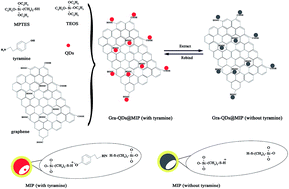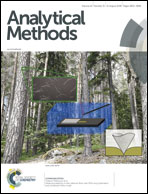A novel fluorescence sensing method based on quantum dot-graphene and a molecular imprinting technique for the detection of tyramine in rice wine
Abstract
Tyramine, an important biogenic amine, occurs in high amounts in certain processed food products and can cause adverse health effects in people. In this study, we developed a simple method to produce a molecularly imprinted fluorescence sensor with high sensitivity and selectivity for tyramine. The reverse microemulsion method was applied to prepare a carrier material, hydrophobic CdSe/ZnS quantum dots (QDs) sensitized with carboxylated graphene (Gra), which was added to the reaction for synthesizing molecularly imprinted polymers (MIPs) using 3-mercaptopropyltriethoxysilane (MPTES) as the functional monomer and tetraethylorthosilicate (TEOS) as the crosslinking agent in the presence of tyramine as the target molecule. The novel sensing material, Gra-QDs@MIPs, was selective for tyramine and generated a concentration-dependent fluorescence signal. Under optimized conditions, the limit of detection was 0.021 mg L−1 and the linear range of detection was 0.07–12 mg L−1. Importantly, we tested the performance of the Gra-QDs@MIPs with real-world samples by demonstrating that they selectively detected around 0.08 or 2 mg L−1 of tyramine in spiked rice wine samples. Hence, the described molecularly imprinted fluorescence sensor for tyramine could serve as a prototype for developing MIP-based assays for food analysis.



 Please wait while we load your content...
Please wait while we load your content...